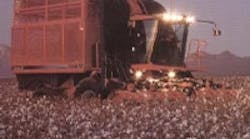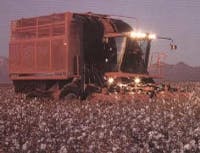HST drives 3-speed gearbox to move huge, 6-row cotton picker.
Cotton picking often goes on around the clock; stadium-lighting package of six halogen lamps creates floodlight pattern for night visibility out in front of the 340-hp, 30- x 20-ft Model CPX610. The machine's 200-gal fuel tank supports 14 hours of continuous operation.
Cotton farming is big business — big as in: if you don't have a lot of acreage, you don't survive. And even though cotton seems inanimate to those of us who only know it as clothing, in the field it has a narrow window of opportunity for picking to maximize the harvest. So when the bolls start to open, and Mother Nature gives you the green light to pick, you want equipment that does it fast and efficiently, and has the stamina to stay on the job until it's finished. The Case IH Cotton Express Model CPX610 meets those criteria.
This 19½-ft-wide machine straddles six rows and picks from both sides of the plant — recovering more cotton from each field. A 340-hp Case IHbranded 6-cylinder (4 valves per cylinder) C Series engine with electronic control powers the 22-ton Model CPX610. The engine drives a pair of Series 1 Model 64 variable-displacement hydrostatic pumps — from Eaton Corp. — directly from its flywheel to supply both the ground drive and the picking-drum system. The pumps flow into a common hose and can produce 100 gpm of combined flow. The closed-loop downstream circuit has a 6000-psi internal pressure override, and is fitted with a 6500-psi safety relief.
The hydrostatic input to the ground drive supplies oil to a Series 1 Model 64 single-speed hydrostatic motor — also from Eaton Corp. — and a pair of Poclain wheel motors on a Tuthill (now Terra Drive Systems) Mud Hog steering axle. The steering axle is at the rear, and its hydraulic circuit includes a flow divider to minimize slippage by the wheel motors. The Eaton motor drives a mechanical train of Case-designed components that consist of an Okubu (now Avon Gear and Engineering Co.) gearbox, 3-speed transmission, and bull-gear-and-pinion final drives at the front axle. This arrangement provides full-time, all-wheel ground drive.
To deal with soft, wet soil and muddy field conditions, and still minimize compaction, the front axle is fitted with high-flotation dual drive tires. Ground speed in first gear (for picking) is 0 to 4 mph; in second gear (for a possible second pass through a picked field) is 0 to 4.8 mph; and in third gear ( for transport) is 0 to 15 mph.
Power for the picking mechanisms also is taken off the Okubu gearbox. By using mechanical drives for the picking functions, there are no belts to slip or chains to lubricate, adjust, or replace. Because the same hydraulic motor powers both the drive axle and the picking mechanisms, Case IH is able to synchronize the picking drums with the CPX610's ground speed in first gear. Synchronized picking minimizes the amount of trash ingestion and stalk damage, while maximizing the quality of the cotton harvested.
The operator controls the ground drive with a simple forward-neutral-reverse propulsion handle that is tied to the hydrostatic pumps through a push-pull cable. The multi-purpose handle also carries switches that control several of the picking functions. Auxiliary hydraulic power for steering and braking is supplied by a belt-driven Vickers PVE 21 variabledisplacement piston pump from Eaton. The pump is rated for 30 gpm and the open-loop, pressure-and flow-compensated system it feeds is set for 2450 psi. The steering wheel operates an Eaton Series 10 steeringcontrol unit mounted in the base of the steering column. The unit provides variable-rate steering; its displacement varies with the input rpm from the steering wheel. The result: more comfortable and predictable steering for the operator, and more productivity for the machine.


